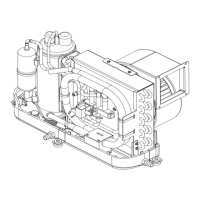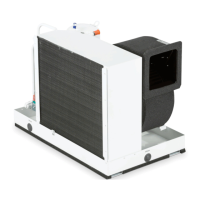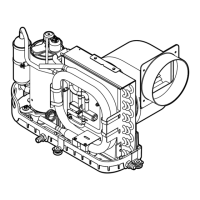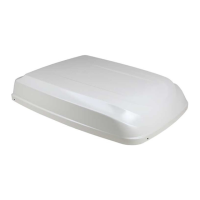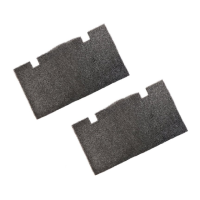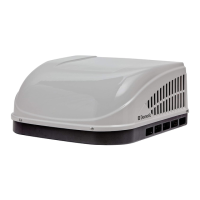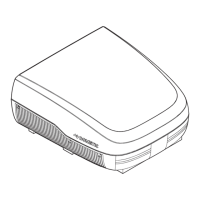9
v
English
L-2086 Installation
ing unit has additional tubing to help with installation. Take care
when bending this tubing as it can easily kink or crack a weld
joint resulting in refrigerant loss.
Both refrigerant lines should be insulated individually.
When putting the recommended closed cell foam insulation
over the tubes, cover the ends of the copper tubes to prevent
foreign material and moisture from getting inside the copper
tubing. After checking for leaks, insulate the connecting are
nut joints and tee-joints to prevent secondary condensation.
Secure tubing every 3 feet (1m) as necessary for support.
The copper tubing is connected to the condensing unit and
cooling/heating unit with are joints. To prevent refrigerant
leaks, ares must be formed correctly with the proper aring
tool. Only 45-degree single ares should be used.
Flares should be made following the instructions of the partic
-
ular aring tool. Make sure to slide the are nut onto the tube
before aring. A drop of oil on the tube can ease the aring
process. The surface of the are face must be smooth and free
of defects to ensure that the joint won’t leak. The are should
be large enough in diameter to ll the are nut completely.
Once you have completed installing the cooling/heating unit
and have made the refrigerant connections between the cool
-
ing/heating unit and the condensing unit, proceed to on to the
next section “Installing The Seawater Cooling System.”
Installing the Seawater Cooling
System
The following installation instructions apply to both self-con-
tained and remote condensing units.
Importance of a Self-Draining Sys-
tem
Along with restricted ducting, a poorly plumbed seawater
system is one of the most common installation problems on
marine air conditioners. When water ow is lost, not only will
the air conditioning units no longer cool or heat, the units and
the pump could be damaged from running with no water ow.
When using a centrifugal seawater pump, it is imperative that the
seawater piping be routed continually uphill from the through-hull
inlet to pump and to the condenser, then smoothly up or down
to the overboard discharge, without any dips or loops, and with
only one high point in the system. This is said to be self-draining
because all water would drain out of the piping if the boat were
lifted out of the water.
Whenever air gets into the system, which can happen in heavy
seas or a sharp turn, it can become trapped in the pump.
Because a centrifugal pump cannot pump air, ow through the
system is lost.
A self-draining seawater system will allow air in the piping to
rise naturally through the pump and then be expelled. It will
also make winterizing the system much easier.
Figure 8 shows a properly plumbed system and some common
mistakes.
Through-Hull Inlet Fitting
A separate through-hull tting must be installed for each air
conditioning seawater pump. Do not attempt to draw water from
an engine, generator, or other through-hull tting.
A scoop-type through hull should be installed facing forward,
and as far below the water line and close to the keel as possi
-
ble.
Drill a properly sized hole for the through-hull tting. Bed the
scoop with marine sealant designed for underwater use, and
tighten the nut onto the through-hull to secure it.
Seacock
A full ow seacock should be installed directly onto the
through-hull tting. Use Threaded-seal tape or other sealant on
the threads. The seacock must be accessible and easy to close
in case of emergency, or to clean the strainer.
Strainer
A seawater strainer must be installed between the seacock
and the pump, and should be situated to provide easy access
for cleaning. The strainer must be located vertically above
the seacock and below the pump so any air that gets into the
strainer can get out.
Make sure the water ow through the strainer is in the correct
direction. Some strainers have an arrow that shows correct ow
direction.
Mount the strainer to a bulkhead so it is properly supported
before connecting hoses. Use Threaded-seal tape or other
sealant on pipe threads.
Seawater Pump
Centrifugal pumps are not self-priming, and must be mount-
ed so that they are below the heeled waterline in any given
operating condition. The pump should be accessible for future
service.
Mount the pump so the outlet is directed upward so air can
escape. The head on some pumps can be rotated to allow
mounting on a vertical bulkhead. See Figure 9.
Self-priming pumps are available if the pump cannot be mount
-
ed below the waterline.
Required seawater owrate is 4 gpm per ton
(12,000 Btu/hr) of total system capacity.

